iPhone 16 Cheatsheet: Key Features, Price, Hacks & More

Learn about the key features, specs, pricing, and everything in between about the release of the iPhone 16 and iPhone 16 Pro.
Since the debut of the original iPhone in 2007, Apple has continuously wowed audiences with its cutting-edge products. The company has gradually improved its iPhone lineup, reshaping the tech industry in the process. This year was no exception.
On Sept. 9, during Apple’s “It’s Glowtime” event, the tech giant unveiled the next-generation iPhone 16 and 16 Pro.
Let’s explore the iPhone 16’s features, performance upgrades, and other innovative enhancements that will have audiences buzzing for months. We’ll also compare each of the models released — the iPhone 16 and the iPhone 16 Pro — and help you decide which model is right for you and your organization.
What are the key features of the iPhone 16 and iPhone 16 Pro?
Contents
The iPhone 16 and iPhone 16 Pro have distinct differences.
The iPhone 16 is Apple’s flagship product, a tried-and-true device for the everyday consumer. Meanwhile, the iPhone 16 Pro is designed for more “professional” users, featuring additional tweaks to the processor speed, camera, and screen that enhance the expectation and deliver a higher-performance device.
Design
Apple has maintained the basic general design of older iPhone models, but with new material upgrades that enhance the iPhone 16 and iPhone 16 Pro. Let’s look at each device and their unique designs.

The iPhone 16, now available in new colors, is made from aluminum, with 85% recycled content in the enclosure. There’s a new color infusion technique that allows for brighter colors, including ultramarine, teal, pink, white, or black color scheme.
The device also features a new Action Button that previously appeared on the iPhone 15 Pro last year, allowing users to program the button to launch applications, shortcuts, and more in iOS 18. The display comes in two sizes: 6.1” for the iPhone 16 and 6.7” for the iPhone 16 Plus.

The iPhone 16 Pro comes in a new screen size and color options from previous years, making it the largest display ever shipped on an iPhone. The Pro models come in a 6.3” and 6.9” option, with the thinnest borders ever made. Using “Grade 5” titanium and 100% recycled aluminum for the chassis, the iPhone 16 Pro comes in black, white, natural, and desert colors. There’s a lighter color-matched back glass.
Both the iPhone 16 and iPhone 16 Pro boast a new glass Ceramic Shield material that Apple claims is 50% tougher than previous models and twice as tough as smartphone glasses from other manufacturers.
Chip upgrades

Apple constantly surprises users by packing a desktop-class chip into such a compact design. This year, both the iPhone 16 and iPhone 16 Pro leverage a 3-nanometer fabrication on their chips — a first for mobile devices — that allows for faster processing. The new chips are also more efficient, extending battery life using existing technologies.
The iPhone 16 includes a new model chip called the A18 that replaces the A16 Bionic chip from the iPhone 15. This new chip is twice as fast as the older version. There’s also 17% more system memory bandwidth than previous chips, useful for machine learning and Apple Intelligence features.
Overall, the new A18 chip is 30% faster than the A16 Bionic. And with the GPU improvements, the iPhone 16 is 40% faster than the iPhone 15. iPhone 16 users will also benefit from ray tracing, thanks to the new chip, and improved sustained performance from the CPU/GPU, supported by a newly designed heat dissipation system from Apple.
The iPhone 16 Pro is also getting a new chip design: the A18 Pro. This silicon-based chip uses the same 3nm technology as the iPhone 16’s A18 but has more cores: most notably, a 16-core neural engine that enables Apple Intelligence to run 17% faster on the iPhone 16 Pro than on the iPhone 15 Pro. This chip also features two-times faster ray tracing and a 6-core GPU, delivering faster performance for games, graphics, and other GPU-related tasks.
The chip is also 20% more efficient than previous iPhone Pro models. There’s a new video and image signal processor in the A18 Pro chip that aims to bring 2x performance to video- and image-related tasks.
SEE: Mobile device security policy (TechRepublic Premium)
Camera Control and camera features

It’s rare that Apple introduces new buttons to the exterior of the iPhone. However, both the iPhone 16 and iPhone 16 Pro received a Camera Control button. This new feature, located on the right-hand side of the device, includes both push and swiping functionalities. To use it:
- Launch the camera by tapping it anywhere inside of iOS.
- Light or force tap to access camera controls.
- Swipe to change settings.
This new button will make it easier for iPhone photographers to capture the perfect shot and adjust settings one-handed with ease.
Both the iPhone 16 and iPhone 16 Pro also received updated camera modules that allow for improved camera workflows for both photography and videography.
Audio upgrades
The iPhone 16 Pro received a significant upgrade to its microphone and audio system.
The Pro has four “studio-quality” microphones and now supports spatial audio capture when recording spatial video. There’s also an “Audio Mix” feature when recording video that uses machine learning to identify and separate voices from background noise, letting you mix the audio while recording based on the recording needs.
Apple Intelligence

The biggest elephant in the room was Apple Intelligence. This is a set of machine learning and artificial intelligence features that Apple has mixed throughout iOS 18. It concerns itself with language, images, and actions for daily tasks, and it is built into the newly revamped Siri to process personal context securely on device and in the cloud with Apple Intelligence Cloud Compute.
Apple Intelligence powers many system features, including Siri, tools for rewriting and proofreading text, and even the ability to create new emojis by simply typing a description. It also helps to find lost photos or videos and even remove photos through the Clean Up editing feature. These features are powered by iOS 18, with additional upgrades coming later in the year with iOS 18.1 and beyond.
Visual Intelligence

Visual Intelligence is a new Apple Intelligence feature introduced alongside the Camera Control in the iPhone 16 and iPhone 16 Pro. It’s similar to Google’s Lens — but processed locally and through Apple’s private Apple Intelligence Cloud Compute architecture.
When tapping on the Camera Control button, you can easily point your camera at a building or sign for Apple Intelligence to identify your location, what you’re viewing, or even create a calendar event based on a flier you spot while walking down the street.
More features of the iPhone 16 and iPhone 16 Pro
According to Apple, both phones:
- Include 100% fiber-based, environmentally friendly, and slimmer packaging.
- Feature new MagSafe cases.
- Are equipped with the new Qi 2 charging standard, which allows for faster charging.
- Boast new, larger batteries that allow for longer run times than previous models.
Additionally, the iPhone 16 Pro has a new 48MP Ultrawide Camera that features a tetra prism design — previously only available on the Pro Max models.
What are the differences between the iPhone 16 models?
| iPhone 16 | iPhone 16 Plus | iPhone 16 Pro | iPhone 16 Pro Max | |
|---|---|---|---|---|
| Capacity | 128GB 256GB 512GB |
128GB 256GB 512GB |
128GB 256GB 512GB 1TB |
256GB 512GB 1TB |
| Size | Width: 2.82 inches (71.6 mm) Height: Depth: |
Width: 3.06 inches (77.8 mm) Height: Depth: |
Width: 2.82 inches (71.6 mm) Height: Depth: |
Width: 3.06 inches (77.6 mm) Height: Depth: |
| Weight | 6.00 ounces (170 grams) | 7.03 ounces (199 grams) | 7.03 ounces (199 grams) | 7.99 ounces (227 grams) |
| Display | Super Retina XDR display 6.1‑inch (diagonal) all‑screen OLED display 2556‑by‑1179-pixel resolution at 460 ppi 1000 nits max brightness (typical); 1600 nits peak brightness (HDR); 2000 nits peak brightness (outdoor); 1 nit minimum brightness |
Super Retina XDR display 6.7‑inch (diagonal) all‑screen OLED display 2796‑by‑1290-pixel resolution at 460 ppi 1000 nits max brightness (typical); 1600 nits peak brightness (HDR); 2000 nits peak brightness (outdoor); 1 nit minimum brightness |
Super Retina XDR display 6.3‑inch (diagonal) all‑screen OLED display 2622‑by‑1206-pixel resolution at 460 ppi 1000 nits max brightness (typical); 1600 nits peak brightness (HDR); 2000 nits peak brightness (outdoor); 1 nit minimum brightness |
Super Retina XDR display 6.9‑inch (diagonal) all‑screen OLED display 2868‑by‑1320-pixel resolution at 460 ppi 1000 nits max brightness (typical); 1600 nits peak brightness (HDR); 2000 nits peak brightness (outdoor); 1 nit minimum brightness |
| Always-on Display? | No | No | Yes | Yes |
| Chip | A18 chip New 6‑core CPU with 2 performance and 4 efficiency cores New 5‑core GPU New 16‑core Neural Engine |
A18 chip New 6‑core CPU with 2 performance and 4 efficiency cores New 5‑core GPU New 16‑core Neural Engine |
A18 Pro chip New 6‑core CPU with 2 performance and 4 efficiency cores New 6‑core GPU New 16‑core Neural Engine |
A18 Pro chip New 6‑core CPU with 2 performance and 4 efficiency cores New 6‑core GPU New 16‑core Neural Engine |
| Camera | 48MP Fusion: 26 mm, ƒ/1.6 aperture, sensor‑shift optical image stabilization, 100% Focus Pixels, support for super-high-resolution photos (24MP and 48MP)
Also enables 12MP 2x Telephoto: 52 mm, ƒ/1.6 aperture, sensor-shift optical image stabilization, 100% Focus Pixels 12MP Ultra Wide: 13 mm, ƒ/2.2 aperture and 120° field of view, 100% Focus Pixels 2x optical zoom in, 2x optical zoom out; 4x optical zoom range |
48MP Fusion: 26 mm, ƒ/1.6 aperture, sensor‑shift optical image stabilization, 100% Focus Pixels, support for super-high-resolution photos (24MP and 48MP)
Also enables 12MP 2x Telephoto: 52 mm, ƒ/1.6 aperture, sensor-shift optical image stabilization, 100% Focus Pixels 12MP Ultra Wide: 13 mm, ƒ/2.2 aperture and 120° field of view, 100% Focus Pixels 2x optical zoom in, 2x optical zoom out; 4x optical zoom range |
48MP Fusion: 24 mm, ƒ/1.78 aperture, second‑generation sensor‑shift optical image stabilization, 100% Focus Pixels, support for super‑high‑resolution photos (24MP and 48MP)
Also enables 12MP 2x Telephoto: 52 mm, ƒ/1.6 aperture, sensor‑shift optical image stabilization, 100% Focus Pixels 48MP Ultra Wide: 13 mm, ƒ/2.2 aperture and 120° field of view, Hybrid Focus Pixels, super-high-resolution photos (48MP) 12MP 5x Telephoto: 120 mm, ƒ/2.8 aperture and 20° field of view, 100% Focus Pixels, seven-element lens, 3D sensor-shift optical image stabilization and autofocus, tetraprism design 5x optical zoom in, 2x optical zoom out; 10x optical zoom range |
48MP Fusion: 24 mm, ƒ/1.78 aperture, second‑generation sensor‑shift optical image stabilization, 100% Focus Pixels, support for super‑high‑resolution photos (24MP and 48MP)
Also enables 12MP 2x Telephoto: 52 mm, ƒ/1.6 aperture, sensor‑shift optical image stabilization, 100% Focus Pixels 48MP Ultra Wide: 13 mm, ƒ/2.2 aperture and 120° field of view, Hybrid Focus Pixels, super-high-resolution photos (48MP) 12MP 5x Telephoto: 120 mm, ƒ/2.8 aperture and 20° field of view, 100% Focus Pixels, seven-element lens, 3D sensor-shift optical image stabilization and autofocus, tetraprism design 5x optical zoom in, 2x optical zoom out; 10x optical zoom range |
| Battery | Video playback Up to 22 hours Video playback (streamed) Audio playback |
Video playback Up to 27 hours Video playback (streamed) Audio playback |
Video playback Up to 27 hours Video playback (streamed) Audio playback |
Video playback Up to 33 hours Video playback (streamed) Audio playback |
What’s the target market for the iPhone 16 and iPhone 16 Pro?
As always, these incremental updates to the iPhone models are aimed at those still using devices older than the previous year’s models. If you’re running anything from iPhone 14 and iPhone 14 Pro or older, then we’d suggest upgrading to iPhone 16.
Users who haven’t upgraded since iPhone 14 will experience new features such as the USB-C and the ability to directly attach storage for Camera recording that was released with iPhone 15 Pro last year — plus the new features of the iPhone 16. The two-year upgrade cycle is generally the best rule-of-thumb with the iPhone and provides the right amount of new features for most users.
Individuals using the iPhone 15 or iPhone 15 Pro may not notice significant upgrades when switching to the iPhone 16. Unless the iPhone 16’s new features are must-haves for your business, we’d suggest holding off until next year’s release.
How much does the iPhone 16 cost, and when will it be available?
The iPhone 16 is available starting at:
- $799 (128GB) for the standard iPhone 16, 6.1” display model.
- $899 (128GB) for the iPhone 16 Plus 6.7” display model.
The iPhone 16 Pro is available starting at:
- $999 (128GB) for the standard iPhone 16 Pro, 6.3” model.
- $1,199 (256GB) for the 6.9” display iPhone 16 Pro Max model.
Both the iPhone 16 and the iPhone 16 Pro will be available for pre-order beginning on Sept. 13 at 8 a.m. Pacific Standard Time. The iPhone 16 and the iPhone 16 Pro will ship for delivery and be available in stores beginning on Sept. 20.
You can purchase the iPhone 16 or iPhone 16 Pro through Apple Stores or participating retailers of your choice in more than 58 countries and regions, including Australia, Canada, China, France, Germany, India, Japan, Malaysia, Mexico, South Korea, Türkiye, the UAE, the U.K., and the U.S.
#iPhone #Cheatsheet #Key #Features #Price #Hacks
